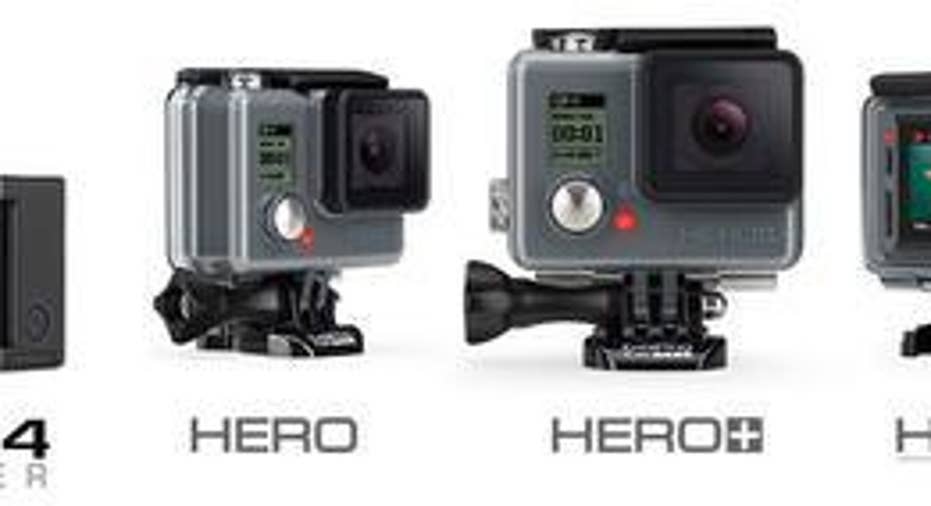Can GoPro Inc's Drone and Hero 5 Cameras Save The Company?

2015 has been a miserable year for GoPro . The action camera maker's stock has plunged nearly 70% due to concerns about slowing growth and a drying pipeline. GoPro's last premium device, the Hero 4 Session, fell short of sales expectations due to poor pricing and marketing. The company then entered the critical holiday season without new flagship devices to replace the Hero 4 Silver and Black.
Looking ahead into 2016, GoPro bulls believe that the company's new drone and flagship cameras will get its sales growth back on track. Let's review what we know so far about these products, and whether or not they can produce "heroic" returns for investors next year.
GoPro's Game of DronesAfter GoPro announced its dismal third quarter earnings, it offered investors two consolation prizes -- a $300 million buybackand this footage fromits prototype drone:
GoPro points out that the video, which looks silky smooth, wasn't stabilized in post-production editing. If average users can film videos as smoothly, it could eliminate the need for vibration isolation mounts, gimbals, and video stabilization software. However, GoPro didn't provide any external views of the drone, list any technical specs, or provide a firm release date.
GoPro's biggest rival in the drone market will be DJI Innovations, the largest drone maker in the world. DJI launched its first Phantom drone two years ago, and its revenue is expected to double this year to $1 billion. DJI's earlier drones included mounts for GoPro cameras, but newer models integrate its own cameras instead. The company also recently introduced Manifold, a Linux computer for drones which can enhance a drone's real-time mapping, data analysis, and image recognition capabilities.
DJI's Manifold on top of a Matrice 100 drone. Source: DJI.
Meanwhile, Intel and Qualcomm are both trying to reduce the cost of drone production withreference designs based on their own chips. Intel integrates its IoT modules and RealSense cameras into drones so that they stay connected while avoiding collisions. Qualcomm is pairing its Snapdragon chips with its own depth-sensing cameras for similar reasons. These cheaper designs could let smaller companies produce more drones and commoditize the market. If that happens, GoPro will need to rely on its premium branding to sell pricier drones.
Analysts expect GoProto generate $2 billion in revenues in fiscal 2016. If GoPro can generate just 20% of DJI's 2015 estimated revenues ($200 million) with drone sales next year, they could easily offset slower growth in action cameras. However, the FAA could ruin that growth with new regulations that could throttle demand for consumer drones in the U.S.
GoPro's aging heroesMeanwhile, GoPro's Hero 5 is rumored to have the ability to record 8K videos and capture 3D images with a dual-lens setup. The device will reportedly sport an A10 processor and a 2,800 mAh battery. The Hero 4 devices were equipped with A9 processors and had muchsmaller 1,120 mAh batteries.
The Hero 5 is expected to be 50% smaller and 40% lighter than the Hero 4 cameras, and come with head gears which allow it to be attached to any part of the body. Its stand-alone waterproof capability will also be upgraded around 20 meters to 60 meters, and it could include a dive housing to secure the gadget while underwater.
Source: GoPro.
These rumors are all unconfirmed, but they follow GoPro's expected upgrade path of a higher top resolution, bigger batteries, and a smaller form factor. The dual-lens setup would be an interesting new feature, which could presumably be used to capture 3D photos and videos, which could be viewed through a VR headset. That content would complement GoPro's VR rigs, which are being used to produce 360-degree videos. However, it's unclear if that niche use will be enough to generate enough mainstream interest.
Relying on 8K video to sell cameras could also be risky, since mainstream consumers haven't fully upgraded to 4K displays yet. 8K videos arrived on YouTube earlier this year, but mostPCs couldn't stream them due to the steep bandwidth and processing power requirements. 8K videos would also fill up memory cards quickly and be tough to edit without a high-end PC. If GoPro's core customers aren't ready to make 3D videos or 8K ones yet, they might stick with their older Hero 4 cameras instead.
The verdictI believe that GoPro investors should be more excited about its upcoming drone than its new flagship cameras. If GoPro's drone works as advertised, it could diversify its top line away from cameras and generate fresh sales growth over the next few years. As for the Hero cameras, GoPro could be running out of room for meaningful upgrades. An upgrade to 3D and 8K videos is impressive, but I'm not convinced that they'll appeal to enough mainstream consumers or current GoPro users.
The article Can GoPro Inc's Drone and Hero 5 Cameras Save The Company? originally appeared on Fool.com.
Leo Sun owns shares of GoPro and Qualcomm. The Motley Fool owns shares of and recommends GoPro and Qualcomm. The Motley Fool recommends Intel. Try any of our Foolish newsletter services free for 30 days. We Fools may not all hold the same opinions, but we all believe that considering a diverse range of insights makes us better investors. The Motley Fool has a disclosure policy.
Copyright 1995 - 2015 The Motley Fool, LLC. All rights reserved. The Motley Fool has a disclosure policy.



















